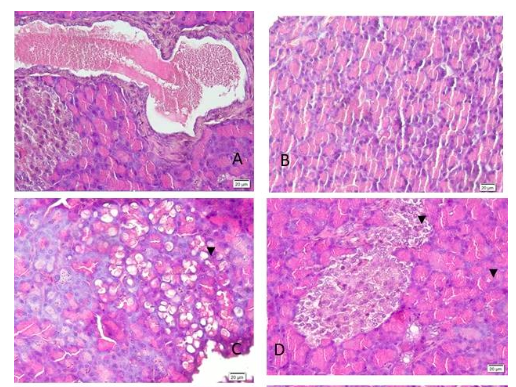Subacute toxicity test of Rhizophora apiculata bark extract on liver and pancreas histopathology of rats
Abstract
Background: Rhizophora apiculata, one of the mangrove plant widely spread in Indonesia, can be developed as a medicinal plant. The extract of the bark has been found to have antioxidant and anti-inflammatory. However, the toxicity of Rhizophora apiculata has not been established yet.
Objective: This research aims to evaluate the toxicity of ethanolic extract of Rhizophora apiculata bark on histopathological changes in rat’s liver and pancreas.
Methods: Subacute toxicity study of the ethanol extract of Rhizophora apiculata bark was performed in healthy male rats by administering the extract at doses of 57, 114, 228, 456, and 918 mg/kg of body weight daily for 28 days. The subacute toxicity in rats was determined by histological analyses.
Results: No significant adverse effect of the extract at dose 57 mg/kg was found. However at and over 114 mg/kg dose of the extract exhibited toxicities to the rats’ liver. In addition, the toxic effect appeared in rats’ pancreas at and over 228 mg/kg dose.
Conclusions: Rhizophora apiculata bark extract showed no toxicity at or below 57 mg/kg. The ethanol extract from bark of Rhizophora apiculata showed toxicity at 114 mg/kg by subchronic toxicity.
References
Rizki R, Leilani I. Etnofarmakologi tumbuhan familia Rhizophoraceae oleh masyarakat di Indonesia. J Bioconcetta. 2017;3(1):51-60. https://doi.org/10.22202/bc.2017.v3i1.2726
Nabeelah Bibi S, Fawzi MM, Gokhan Z, Rajesh J, Nadeem N, et al. Ethnopharmacology, phytochemistry, and global distribution of Mangroves-A comprehensive review. Mar Drugs. 2019;17(4):231. https://doi.org/10.3390/md17040231
Rahim AA, Rocca E, Steinmetz J, Jain Kassim M, Sani Ibrahim M, Osman H. Antioxidant activities of mangrove Rhizophora apiculata bark extracts. Food Chem. 2008 Mar 1;107(1):200-7. https://doi.org/10.1016/j.foodchem.2007.08.005
Gao M, Xiao H. Activity-guided isolation of antioxidant compounds from Rhizophora apiculata. Molecules. 2012;17(9):10675-82. https://doi.org/10.3390/molecules170910675
Thatoi HN, Patra JK, Das SK. Free radical scavenging and antioxidant potential of mangrove plants: A review. Acta Physiol Plant. 2014;36(3):561-79. https://doi.org/10.1007/s11738-013-1438-z
Mustofa S, Bahagia W, Kurniawaty E, Rahmanisa S, Audah KA. The effect of Mangrove (Rhizophora Apiculata) bark extract ethanol on histopathology pancreas of male white rats Sprague Dawley strain exposed to cigarette smoke. ActaBioIna. 2018;1(1):7-13. https://doi.org/10.32889/actabioina.v1i1.2
Mustofa S, Alfa N, Wulan AJ, Rahmanisa S. Pengaruh pemberian ekstrak kulit batang bakau minyak (Rhizophora apiculata) etanol 95% terhadap arteri koronaria tikus putih (Rattus novergicus) jantan galur Sprague Dawley yang dipaparkan asap rokok. J Kedokt Univ Lampung. 2019;3(1):28-33.
Mustofa S, Hanif F. The protective effect of rhizophora apiculata bark extract against testicular damage induced by cigarette smoke in male rats. ActaBiolna. 2019;2(1):23-31. https://doi.org/10.32889/actabioina.v2i1.34
Sulaiman S, Ibrahim D, Kassim J, Sheh-Hong L. Antimicrobial and antioxidant activities of condensed tannin from Rhizophora apiculata barks. J Chem Pharm Res. 2011;3(4):773-6.
Loo AY, Jain K, Darah I. Antioxidant and radical scavenging activities of the pyroligneous acid from a mangrove plant, Rhizophora apiculata. Food Chem. 2007 Jan 1;104(1):300-7. https://doi.org/10.1016/j.foodchem.2006.11.048
Vinod Prabhu V, Guruvayoorappan C. Anti-inflammatory and anti-tumor activity of the marine mangrove Rhizophora apiculata. J Immunotoxicol. 2012;9(4):341-52. https://doi.org/10.3109/1547691X.2012.660997
Selvaraj G, Kaliamurthi S, Thirugnasambandan R. Effect of glycosin alkaloid from Rhizophora apiculata in non-insulin dependent diabetic rats and its mechanism of action: in vivo and in silico studies. Phytomedicine.2016; 23:632-40. https://doi.org/10.1016/j.phymed.2016.03.004
BPOM RI. Pedoman uji toksisitas nonklinik secara in vivo. Jakarta. Kepala Badan Pengawas Obat dan Makanan Republik Indonesia. 2014
Arndt TP, Boone LI. Clinical Pathology of the Rat. In: Suckow MA, Hankenson C, Wilson RP, Foley PL, editors. American College of Laboratory Animal Medicine,The Laboratory Rat (Third Edition). Academic Press; 2020.p. 133-155. https://doi.org/10.1016/B978-0-12-814338-4.00005-2
Chen J, Jiang S, Wang J, Renukuntla J, Sirimulla S, Chen J. A comprehensive review of cytochrome P450 2E1 for xenobiotic metabolism. Drug Met Rev. 2019: 51(2). https://doi.org/10.1080/03602532.2019.1632889
Klaunig JE, Li X, Wang Z. Role of xenobiotics in the induction and progression of fatty liver disease. Tox Res. 2018; 7(4): 664-80. https://doi.org/10.1039/C7TX00326A
Siriwardena AK. Reappraisal of xenobiotic-induced, oxidative stress-mediated cellular injury in chronic pancreatitis: a systematic review. World J Gastroenterol. 2014;20(11):3033-43. https://doi.org/10.3748/wjg.v20.i11.3033
Timotheo CA, Lauer CM. Toxicity of vegetable tannin extract from Acacia mearnsii in Saccharomyces cerevisiae . Int. J. Environ. Sci. Technol. 2018; 15: 659-64. https://doi.org/10.1007/s13762-017-1430-z
Mahmud KN, Hashim NM, Ani FN, et al. Antioxidants, Toxicity, and Nitric Oxide Inhibition Properties of Pyroligneous Acid from Palm Kernel Shell Biomass. Waste Biomass Valor. 2019. https://doi.org/10.1007/s12649-019-00857-w
Puteri FH, Widjaja J, Cahyani F, Mooduto L, Wahjuningrum DA. The Comparative Toxicity of Xanthones and Tannins in Mangosteen (Garcinia mangostana Linn.) Pericarp Extract against BHK-21 Fibroblast Cell Culture. Contemp Clin Dent. 2019;10(2):319-23.
Smeriglio A, Barreca D, Bellocco E, Trombetta D. Proanthocyanidins and hydrolysable tannins: occurrence, dietary intake and pharmacological effects. Br J Pharmacol. 2017;174(11):1244-62. https://doi.org/10.1111/bph.13630
Liu Z, Zhou L, Liu D, Zhu Q, Chen W. Inhibitory mechanisms of Acacia mearnsii extracts on the growth of Microcystis aeruginosa. Water Sci Technol. 2015; 71(6):856-61. https://doi.org/10.2166/wst.2015.038

Copyright (c) 2020 Authors

This work is licensed under a Creative Commons Attribution-NonCommercial 4.0 International License.







